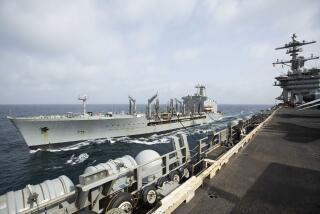34 Americans Killed by Israeli ‘Mistake’ : U.S. Ship Became Target in 1967 War
- Share via
WASHINGTON — At about 2 p.m. on June 8, 1967--the fourth day of what would soon be known as the Six-Day War--Israeli warplanes and torpedo boats repeatedly attacked a U.S. Navy intelligence ship in the only known armed clash between Israel and the United States, an incident that remains controversial despite the passage of two decades.
The coordinated air and naval assault, lasting well over an hour, killed 34 U.S. sailors and wounded 171 others aboard the Liberty, an electronic “ferret” ship deployed in the Mediterranean Sea north of the Sinai town of El Arish to listen in on Israeli and Egyptian military communications.
Israeli investigators concluded that the assault was a tragic accident. The U.S. government did not officially reject that explanation, although Secretary of State Dean Rusk, in a diplomatic note to the Israeli Embassy in Washington, described the attack as “quite literally incomprehensible.”
Was Flying U.S. Flag
Although the Israeli government said the Liberty was mistaken for an Egyptian ship, Rusk said in his note that it was “flying the American flag and its identification was clearly indicated in large white letters and numerals on its hull.”
Like this month’s Iraqi attack on the frigate Stark in the Persian Gulf almost 20 years later, the classification of the incident as a case of mistaken identity served the diplomatic interests of both countries, which were eager to preserve friendly relations.
But unlike the Stark, which was hit by two missiles fired at night, apparently by a single Iraqi jet, the Liberty was strafed and rocketed by several warplanes and attacked about half an hour later by torpedoes from surface patrol boats. The attack occurred in mid-afternoon on a cloudless day.
Although both the U.S. and Israeli governments closed the books on the Liberty case years ago, the story has been kept alive primarily through the efforts of Lt. Cmdr. James M. Ennes Jr., an officer on the Liberty, who, after his retirement from the Navy in 1978, has written extensively about the matter, including a book published in 1979.
Ennes maintains that Israel tried to sink the Liberty to prevent it from overhearing Israeli plans for the soon-to-be-launched invasion of the then Syrian-controlled Golan Heights. He argues that President Lyndon B. Johnson had told Israel that it could count on U.S. support for a war of self-defense but not of aggression.
Pentagon Cover-up Seen
In his book, “Assault on the Liberty,” Ennes wrote: “Could Israel put troops in Syria without being seen as an aggressor? Probably not. Not with the USS Liberty so close to shore and presumably listening.”
Ennes maintains that from the moment of the attack, the Pentagon launched a massive cover-up, both to avoid having to admit that the Liberty was on an espionage mission and to avoid chilling U.S.-Israeli relations.
However, Hirsh Goodman, an Israeli journalist who recently examined the Liberty attack, concluded that it “was a series of horrendous errors on everybody’s part.”
“You don’t listen to preparations for an attack on the Golan Heights from a ship off El Arish,” which is hundreds of miles to the south, Goodman said in a telephone interview.
“It is a fascinating case study of military crisis mismanagement that documents bad decisions and errors caused by fate and bad technology,” he said. “The relevance to the current (Stark) thing is that people really haven’t learned a thing.”
More to Read
Sign up for Essential California
The most important California stories and recommendations in your inbox every morning.
You may occasionally receive promotional content from the Los Angeles Times.










